Secure Checkout + FREE SHIPPING (U.S. Orders over $60)
Menu
-
- Home
-
About Us
-
The Approach
-
Linking Language & Literacy
-
Professional Learning
-
Learning Resources
-
SHOP
-
Blog
-
- About MindWing
- Our People
- Contact Us
- Your Account
- Login
-
United States (USD $)

Secure Checkout + FREE SHIPPING (U.S. Orders over $60)
When No One There Is Like You: Exploring Feelings & “Belonging” with SGM
by Sheila Zagula August 21, 2019 6 min read
 “You’ll face this in your life someday,
“You’ll face this in your life someday,
my mother will tell us
over and over again.
A moment when you walk into a room
and no one there is like you.
It’ll be scary sometimes.
But think of William Woodson
and you’ll be all right.”
This is a quote from the book “Brown Girl Dreaming” by Jacqueline Woodson, quoting her mother’s description of the author’s great-grandfather, William Woodson, who was the only black child in an all-white school. The author collaborated with illustrator Rafael Lopez to create the picture book discussed below.
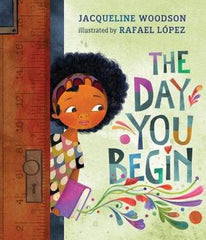 The Day You Begin, by Jacqueline Woodson and illustrated by Rafael Lopez, is a beautiful, nonlinear story to share with children, especially at the beginning of the school year. It encourages children to think about their feelings when entering new situations and creates an opportunity for teachers to provide a discussion with and to show support of children in such situations.
The Day You Begin, by Jacqueline Woodson and illustrated by Rafael Lopez, is a beautiful, nonlinear story to share with children, especially at the beginning of the school year. It encourages children to think about their feelings when entering new situations and creates an opportunity for teachers to provide a discussion with and to show support of children in such situations.
Before sharing the selection, take a look at the following links for background information. This book is actually a story of a girl named Angelina, included with examples and guiding suggestions for belonging, with which all of us can identify. Included below is also a link to the illustrator’s website, Rafael Lopez, discussing the development of the artwork for this book, which older students would find interesting.
As always, read the book for its powerful message, with the aim of coming back to it time and again to explore feelings, belonging, and how we all can welcome others.
The following are ideas to use with this book and the Critical Thinking Triangle (CTT) in Action! Set, grades 2-6. You may change/adjust the activities to meet the needs of the age/goals of students.
Materials:
-
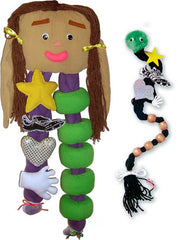 The Day You Begin by Jacqueline Woodson
The Day You Begin by Jacqueline Woodson - SGM® Teacher Marker or Braidy®, depending on which one you use
- Materials from The Critical Thinking Triangle in Action! Set
- Character pictures from The Day You Begin
- Magnetic whiteboard

- SGM® Narrative Magnets
Procedure:
- Ask students to take a few minutes to think of how they felt the first day of school (if you have not started school and wish to use this book on the first day, adjust accordingly).
-
 Have the Feelings/Emotions Bookmark from the CTT in Action! Set available, and depending on the age group—the SGM® Feelings Poster—to help facilitate this activity.
Have the Feelings/Emotions Bookmark from the CTT in Action! Set available, and depending on the age group—the SGM® Feelings Poster—to help facilitate this activity. -
 Hold up the Thought Bubble from the CTT with the question… How did you feel the first day of school?
Hold up the Thought Bubble from the CTT with the question… How did you feel the first day of school?
-
Share the cover of The Day You Begin and the name of the author and illustrator. Tell the students that in this book we will see people
 who are in new settings
who are in new settings  . Ask students to be thinking about how they would feel
. Ask students to be thinking about how they would feel  . Tell students that we will also meet Angelina as she enters her new classroom.
. Tell students that we will also meet Angelina as she enters her new classroom. - Read the story for enjoyment.
-
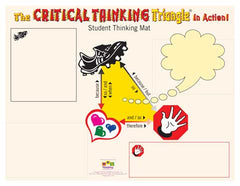 Review the icons on the SGM® with the students. Have ready the CTT mats and feeling words. Place the CTT Student Thinking Mat on the whiteboard with magnets. Review the CTT parts. (If students are new to this, the following activities will give them some practice.) This is a product that may be used with a variety of grade levels, so adjust accordingly.
Review the icons on the SGM® with the students. Have ready the CTT mats and feeling words. Place the CTT Student Thinking Mat on the whiteboard with magnets. Review the CTT parts. (If students are new to this, the following activities will give them some practice.) This is a product that may be used with a variety of grade levels, so adjust accordingly. - Explain that the author has given several examples of students who were in new situations who felt that they did not fit in.
- Hold up the book and share the text/pictures to review each one.
-
Have ready photocopies of the characters from the story and set up the whiteboard as shown. I also used a pocket chart to display the Feeling Cards from the CTT.

-
Go through each character’s setting and feelings, structuring the activity to accommodate your students by providing as much scaffolding as needed. In the first example, we expanded on the use of the illustrations to support the text.
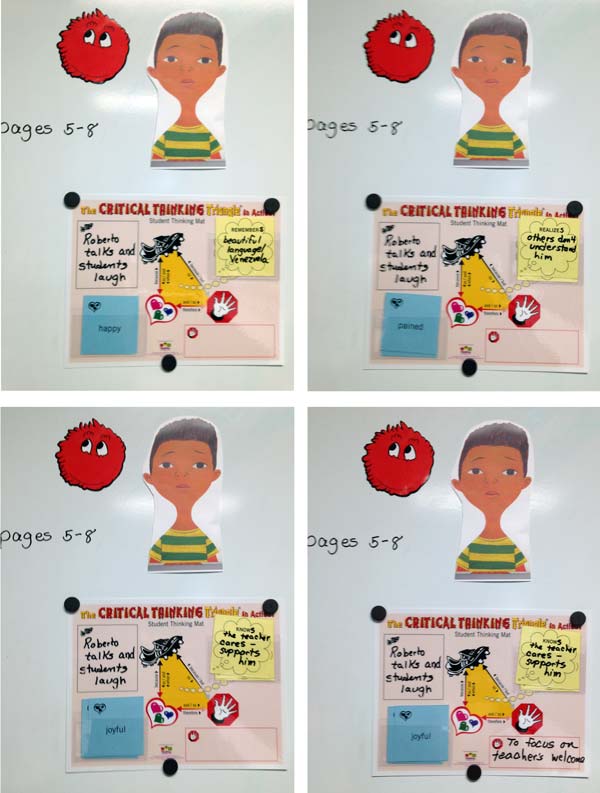
- Notes:
- Point out the contentment shown on Rigoberto’s face as he imagines what he left behind in Venezuela.
- As part of the setting, note the clock which is next to the picture of Rigoberto. Point out the change in his expression from content to sad, unhappy, hurt, pained. This is a great opportunity to discuss synonyms for commonly used feeling words.
- Note the clock again and the change in Rigoberto’s expression when the teacher speaks his name…proud, joyful...point out the staff and musical notes that spread across the page (8).
- Mention that in just a few minutes time-when someone (teacher) says something positive—Rigoberto is encouraged!
- Notes
- Check out the girl’s expression as she sits alone at the table and the way she is holding her lunch box close to herself.
- Note how the other students are staring while one girl is whispering to another, which we assume is about the girl’s lunch.
- Discuss that the table is a ruler. There are other instances of the use of the ruler in the selection. Perhaps measuring how people are feeling…could that be our task?
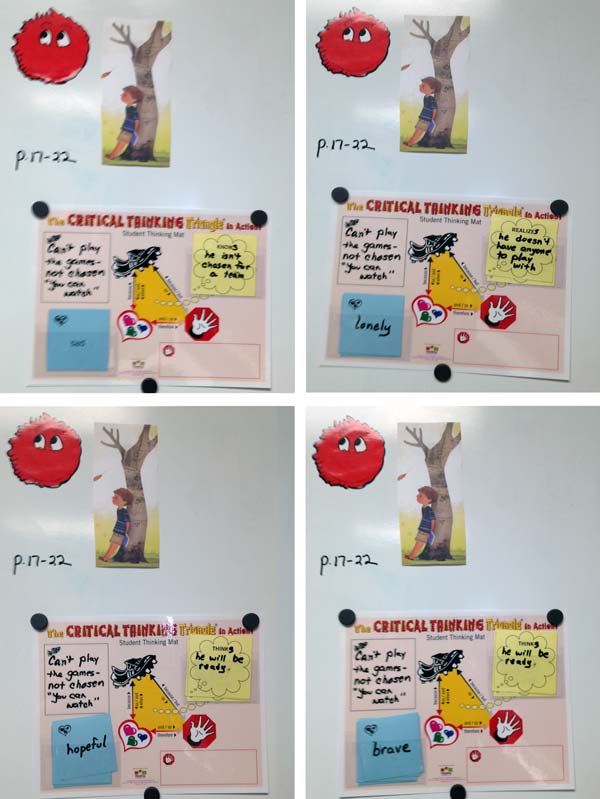
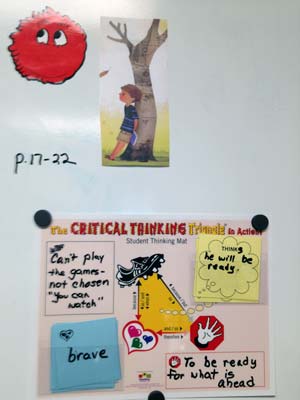 Notes
Notes
- The use of the two pages—the boy leaning against the tree in one and facing the other way in the second—amplifies the isolation/lack of belonging he feels.
- Point out the contrast between the expression of the boy standing at the water's edge and his reflection in the water as he is being brave and “steady as steel” to be ready.
- Note also the differences in the colors used as the book opens in the reflection and has flowers flowing out.
-
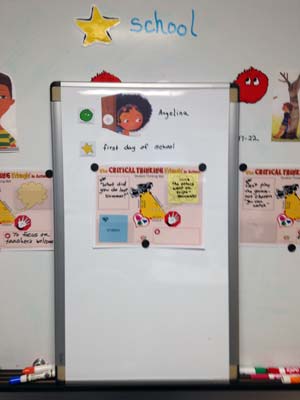 Using the SGM® icons (Character, Setting, Kick-Off), begin by telling the students that Angelina is entering her new classroom on the first day of school and realizes that no one is exactly like she is. Continue using the SGM Mini Magnets and CTT Student Thinking Mat to retell the rest of Angelina's story. Use the text and illustrations to map out the episode similar to the pictures shown.
Using the SGM® icons (Character, Setting, Kick-Off), begin by telling the students that Angelina is entering her new classroom on the first day of school and realizes that no one is exactly like she is. Continue using the SGM Mini Magnets and CTT Student Thinking Mat to retell the rest of Angelina's story. Use the text and illustrations to map out the episode similar to the pictures shown.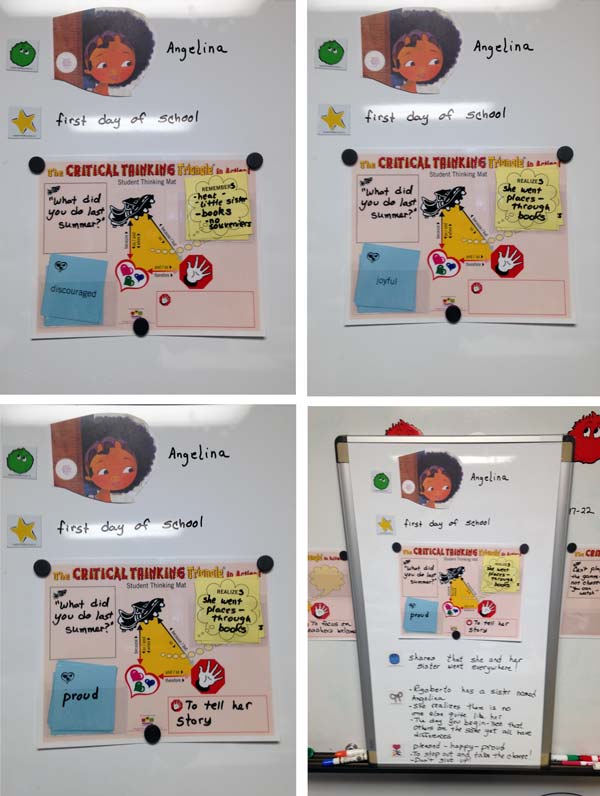
- Emphasize what Angelina learned.
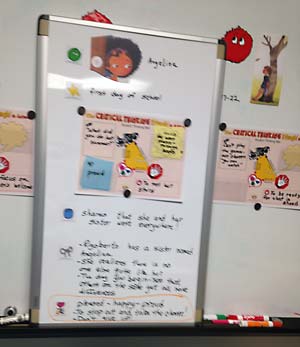
- Go back to the original list of feelings from #1. Discuss and circle those that were the same as some of the feelings from the story. Connect the fact that we experienced similar feelings when entering a new setting.
- Conclude the lesson by asking students what they have learned from this selection. Invite students to Turn and Talk with a partner, then share suggestions for class/group discussion.
- There are many outgrowths in this lesson.
- Invite students to share ideas on how they can help others feel more welcomed in new situations. Create a list of suggestions.
-
 Isolate some of the feeling words, give students a CTT Student Thinking Mat or a copy of the CTT Student Thinking MAP and ask students to make notes to discuss (or write about) a time they have felt similar. Focus on the thought bubble and ask students what they were thinking when they had a certain feeling.
Isolate some of the feeling words, give students a CTT Student Thinking Mat or a copy of the CTT Student Thinking MAP and ask students to make notes to discuss (or write about) a time they have felt similar. Focus on the thought bubble and ask students what they were thinking when they had a certain feeling. -
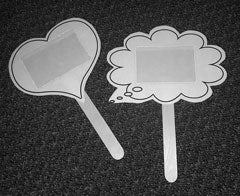 Use just the Feeling icon and Thought Bubble from the set, attached to popsicle sticks to isolate these two components.
Use just the Feeling icon and Thought Bubble from the set, attached to popsicle sticks to isolate these two components. - Work with students who are having difficulty adjusting to the school setting, relating feelings of characters in the story and the message of trying to move forward.
- Reading this book selection is a rich opportunity to involve other school personnel—guidance counselor, administrator, health teacher, speech pathologist—in a discussion with students.
-
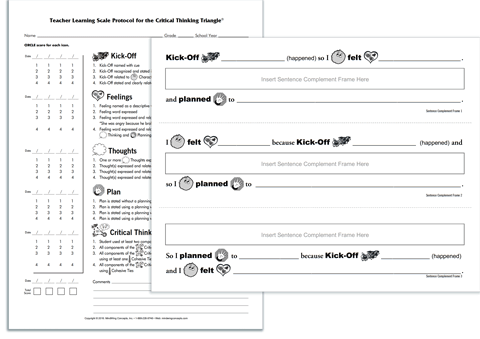 There are additional materials in the CTT in Action! Set such as sentence frames and rubrics to help facilitate individual student participation.
There are additional materials in the CTT in Action! Set such as sentence frames and rubrics to help facilitate individual student participation. - The Feeling words poster/bookmark will help develop the vocabulary needed to accurately express feelings.
- Don’t forget to role play with students—and adults—the situations presented in The Day You Begin and the possible outcomes.
- Focus on the illustrations and how they complement and expand on the message of courage and belonging. There are many sites online that explore this connection. In addition to the above links, this one from The Horn Book Inc. is very helpful.
 The ability to recognize and express feelings is so needed with students and adults. Read Maryellen’s recent post: Oral Language and Trauma: “Nobody Made the Connection,” related to the connection and importance of oral language development to trauma.
The ability to recognize and express feelings is so needed with students and adults. Read Maryellen’s recent post: Oral Language and Trauma: “Nobody Made the Connection,” related to the connection and importance of oral language development to trauma.
 Our blog “Each Kindness For Valentine’s Day and Black History Month” explores another book by Jacqueline Woodson, Each Kindness.
Our blog “Each Kindness For Valentine’s Day and Black History Month” explores another book by Jacqueline Woodson, Each Kindness.
Check out these links to previous blogs to help “Kick-Off” ![]() the new school year:
the new school year:
9 Books, 3 Activities & 4 FREE Downloads for Kicking-Off Back-to-School!
And, as always, check out our website for loads of lessons, activities, webinars, materials, and suggestions to take you through the school year!
Sheila Zagula
Sheila Zagula works with MindWing Concepts in product development, drawing on her expertise and talents as well as many years of implementing the Story Grammar Marker® and related materials. Her teaching career spans thirty-eight years, most recently as literacy coach in the Westfield Massachusetts Public School System. Sheila has experience as an early childhood educator, a teacher of children with special needs, and a collaborative instructor within an inclusion framework serving children in grades K-5.
Leave a comment.
Comments will be approved before showing up.





 The Day You Begin by Jacqueline Woodson
The Day You Begin by Jacqueline Woodson
 Hold up the Thought Bubble from the CTT with the question… How did you feel the first day of school?
Hold up the Thought Bubble from the CTT with the question… How did you feel the first day of school? Review the icons on the SGM® with the students. Have ready the CTT mats and feeling words. Place the CTT Student Thinking Mat on the whiteboard with magnets. Review the CTT parts. (If students are new to this, the following activities will give them some practice.) This is a product that may be used with a variety of grade levels, so adjust accordingly.
Review the icons on the SGM® with the students. Have ready the CTT mats and feeling words. Place the CTT Student Thinking Mat on the whiteboard with magnets. Review the CTT parts. (If students are new to this, the following activities will give them some practice.) This is a product that may be used with a variety of grade levels, so adjust accordingly.

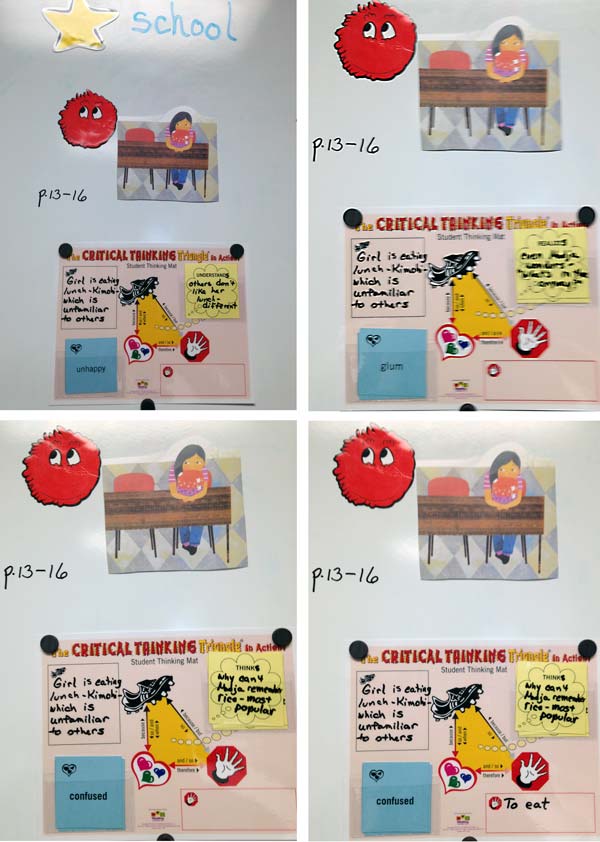

 Notes
Notes Using the SGM® icons (Character, Setting, Kick-Off), begin by telling the students that Angelina is entering her new classroom on the first day of school and realizes that no one is exactly like she is. Continue using the
Using the SGM® icons (Character, Setting, Kick-Off), begin by telling the students that Angelina is entering her new classroom on the first day of school and realizes that no one is exactly like she is. Continue using the 

 Isolate some of the feeling words, give students a CTT Student Thinking Mat or a copy of the CTT Student Thinking MAP and ask students to make notes to discuss (or write about) a time they have felt similar. Focus on the thought bubble and ask students what they were thinking when they had a certain feeling.
Isolate some of the feeling words, give students a CTT Student Thinking Mat or a copy of the CTT Student Thinking MAP and ask students to make notes to discuss (or write about) a time they have felt similar. Focus on the thought bubble and ask students what they were thinking when they had a certain feeling. Use just the Feeling icon and Thought Bubble from the set, attached to popsicle sticks to isolate these two components.
Use just the Feeling icon and Thought Bubble from the set, attached to popsicle sticks to isolate these two components. There are additional materials in the CTT in Action! Set such as sentence frames and rubrics to help facilitate individual student participation.
There are additional materials in the CTT in Action! Set such as sentence frames and rubrics to help facilitate individual student participation.